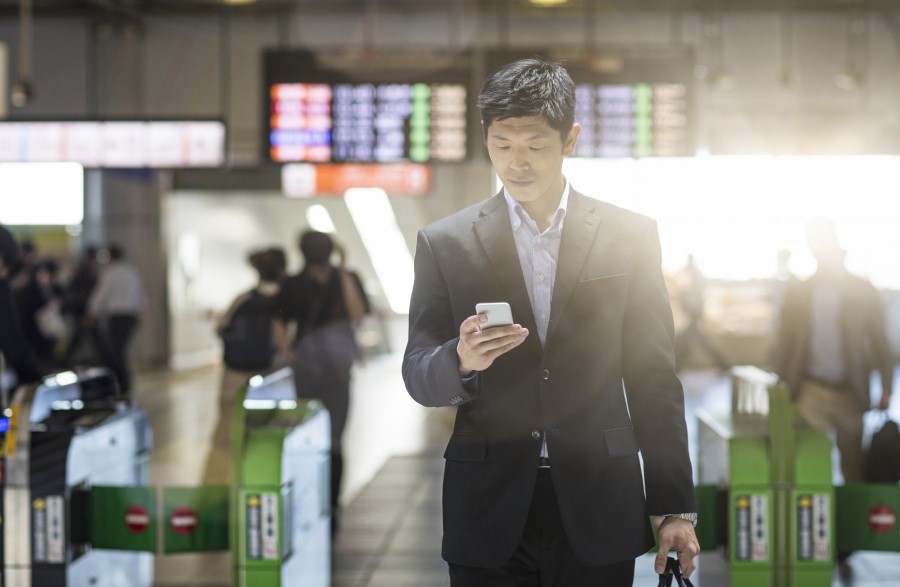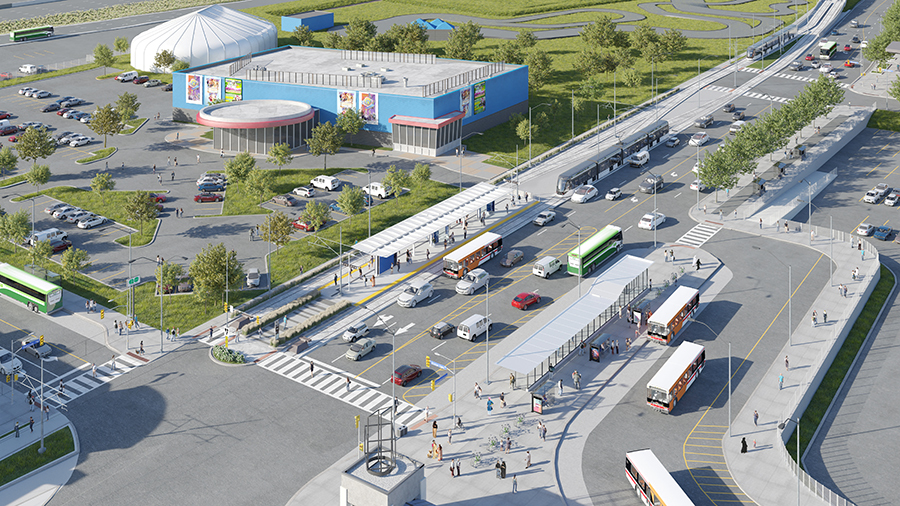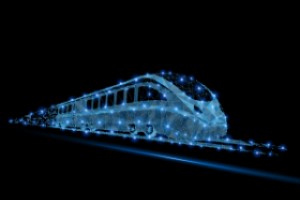By Jian Sun, Director of Business Development – Systems Innovation, Hitachi Rail
In order for US cities to continue to grow they must confront the major challenge of urban mobility. According to the US Census Bureau’s early estimates of the 2020 census, the majority of the country’s largest cities are growing at a faster rate than they were a decade ago.i This continued growth is already putting undue stress on transportation infrastructure throughout North America. If not properly managed, these strains can cause dramatic shifts in quality of life for residents. People will struggle to get to work, school, and other daily duties, while goods and services will be delayed or simply fail to reach their intended destination.
Fortunately, the key to future economic growth is coming down the tracks. According to a report from the National Institute of Standards and Technology entitled, The Emerging U.S. Rail Industry, rail transit is critical to the growth of the US economy, both for cities and the manufacturing sector.ii For example, passenger rail systems spur economic development, connect metropolitan areas with the suburbs, and help reduce roadway congestion.
To meet the requirements of today without compromising the needs of future generations requires the implementation of new intelligent rail systems that are environmentally and economically sustainable. They must run more efficiently, reliably, and safely in order to improve the quality of life for everyone. Smart rail systems are much more than just well-built, safe trains — they are intelligent, fast-moving ecosystems.
Communities looking to the future are already prioritizing sustainable transportation. In response, Hitachi, a socially responsible supplier to the rail industry, has designed and is now implementing new rail systems that promise to “future proof” rail service. These include asset management platforms where Hitachi provides seamless support with integrated digital rail solutions as well as a Mobility-as-a-Service (MaaS) model that allows cities to partner with suppliers in order to make the best use of available funds.
A major issue with investing in future transportation infrastructure is the fact that cities are now facing constraints in funding, particularly in light of the extraordinary and unanticipated costs of providing safe, essential services during the COVID-19 pandemic. Adding to the challenge is a weaker economy due in large part to government enforced lockdowns that has further decreased tax collections – the chief income source for most local governments.
The pandemic’s toll on the economy can be felt within a number of public transit authorities across the nation. These entities now require an estimated $32-billion in federal emergency funding to continue operations. Without that aid, 60% of U.S. public transit systems will have to reduce services, according to the Association of Public Transportation Authority’s most recent members’ survey (released 9/16/2020).
The economy will recover, growth will continue, and the need to invest in infrastructure must be prioritized in order to deliver a safer, more convenient and more sustainable mass transportation solution within and between metropolitan areas.

Intelligent rail systems have the ability to deliver environmental, economic and social value to customers, whether they be passengers, transit operators, or the public sector. In partnership with these three critical stakeholders, the rail industry must continue to conceive, design, build, and implement solutions that relieve congestion and reduce pollution.
The new MaaS model of public-private partnerships leverages limited budgets in ways that improve the operation and maintenance of transport systems. Rather than having to make large, upfront expenditures in the public-private partnership model, cities partner with companies like Hitachi to build, operate, and maintain these intelligent rail systems. Not only does this approach change the funding model for key projects, it also means that private companies have a long-term stake and investment in the outcome. The better the system performs, the more passengers will want to use it, which results in continuing revenue for the operators.
As an example, in Canada, Hitachi is a member of a consortium that is designing, building, financing, operating and maintaining the Hurontario LRT, a light-rail system in the greater Toronto area. The system is set to open in 2024 and will better connect passengers to other modes of transportation (also referred to as multimodal connections) in a cost-effective manner.
Similarly, Hitachi is building a new driverless metro system in Hawaii with the Honolulu Authority for Rapid Transportation (HART). Designed as the heart of the island of Oahu’s multimodal transport system, HART will be America’s longest automated, driverless, urban light metro system. By 2030, it is expected to handle more than 120,000 passenger trips each day while significantly reducing citizen’s reliance on motor vehicles.iii
Hitachi’s decades of experience and expertise enables it to develop these intelligent, modern rail systems — not only in railway signaling and systems technology but also in information technology, electronics, software development and in IoT technology. With a long history of successful systems design, engineering, integration and operation, Hitachi is helping smart cities everywhere implement and run sustainable, integrated transportation systems.

Rathburn Road Aerial View of the new Hurontario Light Rail to be developed by Hitachi and the Mobilinx Consortium for a portion of Ontario, Canada.
Intelligent rail service will play a fundamental role in meeting the challenges of a growing population. Smart rail is a future proofing solution because it provides a safe, high capacity, low emission solution for mass transit in high-density urban areas. Not only does it offer a greener alternative for transporting suburban commuters to and from metropolitan areas, but it typically links to other critical transportation hubs like ferries, airports, and the not-so-distant future reality of spaceports. Smart cities can become even more sustainable with autonomous, on-demand, and networked rail services.
Rail is a safe, effective way to move large numbers of people quickly and reliably — and modern, intelligent rail systems are evolving to be economically sustainable and even more environmentally friendly. Intelligent rail is a key asset for end-to-end, multimodal service.
Although the transition to electric and autonomous vehicles may improve sustainability, it produces its own challenges such as the high cost of building out the infrastructure for power distribution and charging stations. It also will not address more pronounced problems such as congestion or the added stresses to aging highways, roads and bridges that make up the nation’s infrastructure.
Additionally, electric vehicles may improve environmental conditions within cities, but the positive impacts are limited because the power to charge these vehicles is still overwhelmingly generated from fossil fuel–based power plants.
In the push for U.S. transportation decarbonization, revitalizing rail is crucial for a low-carbon transport choice. Hitachi Rail invests in eco-tech like Hyperloop, hydrogen, biofuels, batteries, and driverless systems to forge net-zero rail transport, fostering a sustainable shift.
Intelligent rail helps cities optimize investments that have already been made so that they can deliver “the mobility of tomorrow.” The goal is to improve the end user’s experience without compromising on sustainability.
As a result, Hitachi has developed an intelligent asset management platform to meet the coming customer demand for integrated digital rail solutions. Hitachi can provide seamless support to transit authorities or rail operators with on-train and wayside digital solutions, real-time monitoring and supervision, alarms and warning notifications, condition-based maintenance, data management, analytics and advanced data processing, remote control and management, life cycle asset management, and planning and decision support.

One of the most exciting elements of intelligent rail systems is their ability to collect and analyze data in order to help operators better predict when and exactly where to concentrate their maintenance and repairs — and even warn of an imminent failure. For example, when a physical device requires repair, an intelligent rail system lets the operators know exactly where the repairs are needed, pinpointing system stresses ahead of a potential failure or breakdown.
Hitachi’s intelligent rail system’s predictive maintenance helps operators avoid potential shutdowns — reducing the inconvenience to passengers while increasing revenue. In manufacturing, McKinsey estimates that predictive maintenance will create between $500 billion and $700 billion worth of value for businesses.
The diagnostics tools in predictive maintenance solutions can also identify issues and help operators fix software issues remotely. This means the system can detect and adjust to real-time conditions. For example, a major cause of train delays in subway systems occur when doors fail to properly close. With IoT components - such as door sensors - intelligent rail systems can self-diagnose, identify and locate the problem, and dramatically reduce such delays.
Furthermore, Hitachi has developed applications to screen passengers in the waiting area. When paired with contact tracing, such applications can indicate when an operator needs to take high-risk vehicles out of service for cleaning.
Another huge benefit of an integrated, connected intelligent rail system is that the data can be used to meet the required passenger demand. For example, Hitachi’s driverless metro system in Copenhagen adjusts the frequency of service by monitoring passenger numbers in real time. It detects the flow of people, adjusting the schedule of trains at peak times by sensing the number of people on the train platforms. It automatically sends more trains as needed. That means shorter wait times, less congestion and a much smoother trip. This has proven to be hugely beneficial during big sporting or entertainment events where demand tends to spike at unanticipated times. This translates to happier passengers who are more likely to use that transit system again in the future.
Transit authorities could also reduce congestion and improve the travel experience for passengers by partnering with local vendors in creative ways. Imagine getting an alert on your smartphone offering a free cup of coffee while you wait for the next train. Additionally, dynamic scheduling in this Mobility-as-a-Service model means your phone can sync bus and train times, so passengers can step off the train and quickly onto their bus heading home. It also adjusts these multimodal schedules by taking into account road conditions, traffic patterns and the weather.
In the evolving urban transportation landscape, connected autonomous rail systems emerge as a sustainability beacon, signaling a transformative passenger experience. Enhanced safety, unmatched efficiency, lower energy use, and shorter wait times define this new rail era, paving a promising route to a greener mobility future.
By sustainably managing the movement of people and goods across different modes of transport, cities can dramatically improve service for their citizens. The quality of urban life is also enhanced when people are able to attend a mix of cultural, artistic and sporting events without having to worry about transportation headaches. Hitachi Rail meets these needs through intelligent rail systems.
Hitachi works as a partner with its customers and invests in innovative rail solutions. The goal is to improve the journey for passengers, operators and public authorities. It collaborates with customers to create solutions through continuous value engineering, identifying the solutions that best meet the needs. Hitachi’s focus on social innovation is at the heart of the design, implementation and operation of these systems with a commitment to powering future growth.
Hitachi estimates that its intelligent rail services and solutions helped 18 billion people travel from one point to another last year and that’s just the beginning. By leveraging its social innovation business model, projected carbon emissions can be reduced by as much as 10%, congestion by as much as 20%, and road traffic accidents by 25%.iv By improving transportation systems in a scalable, sustainable way, cities can make a huge impact on the quality of life for both visitors and residents.
Learn more about how Hitachi Social Innovation is powering good. Get to know one of the world’s most-recognized total railway solutions providers, here.

Director of Business Development – Systems Innovation, Hitachi Rail
Jian Sun Ph.D. leads Business Development for Hitachi Rail STS in North America. A systems’ thinker, Dr. Sun’s responsibilities include developing technical solutions for the rail business and promoting integrated solutions across Hitachi Group companies. He focuses on helping customers with railroad digitization to augment their existing signaling systems, enhance their operations and improve the passenger experience. Sun is a Member of the Institution of Railway Signal Engineers.